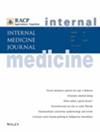Intravenous administration of ferric derisomaltose is associated with a higher incidence of infusion reactions than ferric carboxymaltose, and unaffected by dilution volume
Abstract
Background
The incidence of and risk factors for infusion-related reactions to intravenous iron formulations remains poorly characterised. This study aimed to compare the rates of infusion reactions in patients receiving ferric derisomaltose (FDI) compared to ferric carboxymaltose (FCM), as well as across different dilutions of FDI.
Aims
To compare the rates of infusion reactions in patients receiving ferric derisomaltose (FDI) compared to ferric carboxymaltose (FCM), as well as across different dilutions of FDI.
Methods
This was a single tertiary centre retrospective matched cohort study of patients who received FDI or FCM between January 2022 and May 2023. Reactions were classified as Fishbane or hypersensitivity and characterised by severity using the Ring and Messmer classification.
Results
A total of 660 patients (330 age- and sex-matched patients who received FDI and FCM, respectively) were included. Hypersensitivity reactions occurred in 34 of 330 (10.3%) patients receiving FDI infusions compared to eight of 330 (2.4%) patients receiving FCM (odds ratio (OR), 4.62 (95% confidence interval (CI), 2.10–9.78), P < 0.0001). All reactions to FCM and FDI were classified as mild to moderate except for one grade III reaction to FDI. There was no difference in the rate of reaction between patients receiving FDI diluted in 100 mL (18/165) compared to 250 mL (16/165) sodium chloride (OR, 1.14 (95% CI, 0.55–2.27), P = 0.86). A history of a reaction to an alternative iron formulation was associated with increased risk of infusion reactions (OR, 3.55 (95% CI, 0.67–18.97), P = 0.14) and increasing age was associated with reduced risk (OR, 0.96 (95% CI, 0.94–0.99), P = 0.02).
Conclusion
Patients receiving FDI had a significantly higher risk of mild infusion reactions compared to those receiving FCM, with no difference across different dilution volumes of FDI.


 求助内容:
求助内容: 应助结果提醒方式:
应助结果提醒方式:


